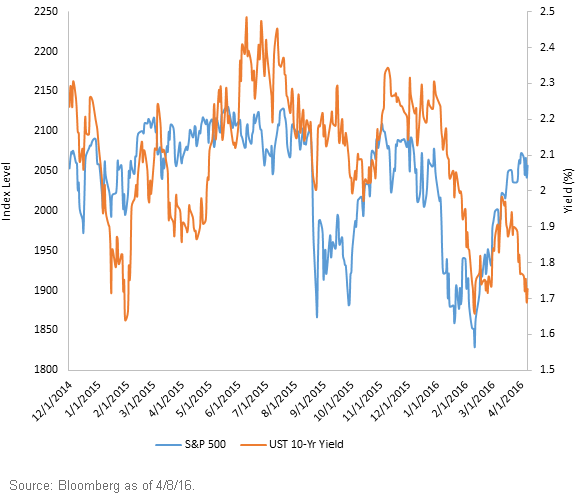
Head of Fixed Income Strategy
Follow Kevin Flanagan
One of the more notable influences in the
U.S. Treasury market (UST) over the last five years or so has been the flight-to-quality or
safe-haven trade. In market parlance, it has been better known as the risk-on/risk-off trade.
A variety of factors have created this environment in the past; most recently, we addressed this topic in our February blog post
U.S. 10-Year Treasury Yields: “Groundhog Day: The Sequel”. Specifically, we looked at the dynamic that was playing out between the
S&P 500 Index and the
UST 10-Year yield. Indeed, throughout the first six weeks of the current calendar year, it was readily apparent that there was a tight
correlation between falling U.S. equity prices and the rather visible drop in the 10-Year yield. In fact, this trend reached its peak on Feb. 11, when the S&P 500 had dropped nearly 250 points from its year-end high, while the UST 10-Year had witnessed a 65
basis-point (bps) plunge in yield during the same time frame. Following this safe-haven bid for Treasuries, the markets then reversed course, with the risk-on trade dominating. Once again, stocks and bonds experienced another tight correlation, but this time around, the trend was reversed, as the S&P 500 moved up off its aforementioned low while UST 10-Year yields began a renewed ascent.
Interestingly, this relationship only lasted for about a month and was followed by an obvious disconnect. To provide perspective, up until March 11, the S&P 500 recouped almost 78% of its losses during the first six weeks of the year. At the same time, the UST 10-Year yield rose more than 30 bps and was just below the 2% threshold. As the graph below clearly illustrates, the correlation between stocks and Treasuries then began to break down. In other words, while stocks were continuing their upward move, the UST market also rallied, with the UST 10-Year yield falling back down to 1.69% last week.
The natural question to ask is what type of catalyst could cause both the stock and bond markets to rally at the same time. Certainly, the
Federal Reserve (Fed) interjected itself into the equation on two separate occasions during the month of March, and both instances were perceived as leaning toward the unexpectedly
dovish side of the policy equation. The first instance was the
FOMC meeting, which was followed by what some commentators have dubbed the “Yellen celebration,” or the Fed chair’s much ballyhooed public comments a couple of weeks ago. As a result, Fed
rate hike expectations have noticeably dialed back. To be sure, the December
Fed Funds Futures contract now barely prices in one rate increase for this year.
S&P 500 vs. UST 10-Year Yield
 Conclusion
Conclusion
So what lies ahead for the UST market, and should we expect to see the correlation with the S&P 500 returning any time soon? The first week of trading in April witnessed a bit of a return of the risk-off, or safety, trade. Most Treasury yields have now fallen close to the lows registered back in mid-February. As we have seen in just the last few months, this factor can have its ebbs and flows. That being said, the safety or risk-on/risk-off trade is likely to remain an integral part of the UST market landscape throughout the rest of the year.


 Conclusion
So what lies ahead for the UST market, and should we expect to see the correlation with the S&P 500 returning any time soon? The first week of trading in April witnessed a bit of a return of the risk-off, or safety, trade. Most Treasury yields have now fallen close to the lows registered back in mid-February. As we have seen in just the last few months, this factor can have its ebbs and flows. That being said, the safety or risk-on/risk-off trade is likely to remain an integral part of the UST market landscape throughout the rest of the year.
Conclusion
So what lies ahead for the UST market, and should we expect to see the correlation with the S&P 500 returning any time soon? The first week of trading in April witnessed a bit of a return of the risk-off, or safety, trade. Most Treasury yields have now fallen close to the lows registered back in mid-February. As we have seen in just the last few months, this factor can have its ebbs and flows. That being said, the safety or risk-on/risk-off trade is likely to remain an integral part of the UST market landscape throughout the rest of the year.


